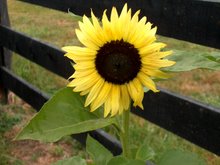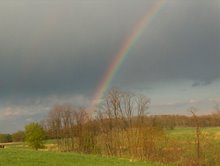Thursday, August 09, 2007
Farmers Market - Saturday August 11th
Wow the summer has really been racing by. We'll have lots of very nice red sweet peppers at the market this Saturday as well as numerous kinds of hot peppers. We have lots of different kinds: Jalapeno, Thai, Caribbean, Cayenne, red chili, etc. , quite a variety. We'll have these packed in pints. Sadly, the blueberries are all gone for the year. I know many of you really enjoyed them too. But they've now been replaced by an abundance of blackberries. So dig out that blackberry cobbler recipe or get one on line or at www.raspberryblackberry.com We'll have red raspberries too. That along with the usual tomatoes, green peppers, squash, honey, eggs, etc. We're getting some storms tonight (Thursday eve) but only about 1/3" of much needed rain so far. Hopefully it will continue overnight. Hope to see you Saturday morning in Romney!
WV Fresh Logo
 We attended a meeting at Fairmont State University yesterday where the new WV Fresh Logo was unveiled. The WV Collaborative web site wvfarm2u.org will be going live next week after it is presented at the WV State Fair. Farms that have been involved with the Sustainable Agriculture Research and Education (SARE) program like us were participants in the meeting at Fairmont yesterday. Its a nice logo and its getting some good publicity nationwide. The web site will help connect stores, restaurants, and the public with local producers. We'll be listed there as a producer when it goes live next week. On our way home we visited the WVU Organic Research Farm in Morgantown where they were having an open house and field day. Quite an informative day yesterday.
We attended a meeting at Fairmont State University yesterday where the new WV Fresh Logo was unveiled. The WV Collaborative web site wvfarm2u.org will be going live next week after it is presented at the WV State Fair. Farms that have been involved with the Sustainable Agriculture Research and Education (SARE) program like us were participants in the meeting at Fairmont yesterday. Its a nice logo and its getting some good publicity nationwide. The web site will help connect stores, restaurants, and the public with local producers. We'll be listed there as a producer when it goes live next week. On our way home we visited the WVU Organic Research Farm in Morgantown where they were having an open house and field day. Quite an informative day yesterday.
Excellent WV Photo
 As you know by now, any good photos we have are a result of Ruth's skill and eye for detail. Here's another WV landscape that I think just about captures it all. Taken near our house. You've got the the fields, woods, pond, mountains in the distance, an apple tree, big open sky, nice clouds. All the best of WV. But note the drought stress in the sunflower leaves and grass. Sure there is human interference, the road, the rowboat, the distant building rooftop, but it does not overtake the natural setting. Like a park. Which may actually be the point. Living in WV is like living in a pastoral park. Great photos like this capture the foreground detail, a middle subject, and the far distance.
As you know by now, any good photos we have are a result of Ruth's skill and eye for detail. Here's another WV landscape that I think just about captures it all. Taken near our house. You've got the the fields, woods, pond, mountains in the distance, an apple tree, big open sky, nice clouds. All the best of WV. But note the drought stress in the sunflower leaves and grass. Sure there is human interference, the road, the rowboat, the distant building rooftop, but it does not overtake the natural setting. Like a park. Which may actually be the point. Living in WV is like living in a pastoral park. Great photos like this capture the foreground detail, a middle subject, and the far distance.
Sunday, August 05, 2007
Color Guide to Staying Healthy and Eating Right
I found this article at the Lifehacker blog. Its a good description of nutrition and food colors. Click the link above or Here for the article.
Friday, August 03, 2007
Hot Peppers
Some folks have been asking for weeks now and finally the hot peppers are ready. Mostly jalapeno. We'll have them at the Romney Farmer's Market tomorrow. We have them packed in pints this year. Some Thai hot peppers will also be available shortly. We'll also have plenty of sweet peppers again. Some were allowed to turn red. Very sweet. Still lots and lots of tomatoes. A slight bit of misfortune with the heirloom tomatoes. From the big storm last Saturday evening we got about 2 " of rain. This was just too much for the thin skinned heirlooms as many of them cracked and split with the rapid moisture uptake. So the heirlooms may get picked out in the next week or so. We have lots of nice large blackberries in pints and red raspberry pints also. No matter how many we bring they sell out in the first hour. Been meaning to mention eggs also. We have them in a cooler and often forget to display them. We'll have 10 dozen or so for tomorrow. Lastly, tomorrow will be the last day for Richard Cutter's blueberries which we have been selling for him. Looks like we are into a long stretch of 90 degree muggy days. Great for homemade ice cream and with fresh fruit. Hope to see you at the market on Saturday.
Wednesday, August 01, 2007
Aroma's Coffeehouse
Catching up on blog posts today that I've neglected for a while so on this very hot afternoon its desk clearing time. If you are in Moorefield, WV looking for a nice place to eat or have a good cup of coffee, do yourself a favor and stop at Aroma's Coffee House. See www.aromascoffeehouse.biz Its on the main street running through town. Its quiet and comfortable with nice tables, sofas and free WiFi. Basically its like your den at home. Proprietor JD and his wife treat every customer like a part of their family. They also roast their own coffee on site. They became our customers this year and they have a keen interest in serving local and seasonal produce at Aroma's. A few of their lunches are shown on their web site. Check it out. JD takes a special pride in checking that each and every customer is very satisfied with their visit. Each and every town in this country needs a place like this.
WV Gazette Article and On Line Guide
WV Gazette staff writer Tara Tuckwiller has been writing about WV local foods and had a good article in the paper on July 22nd. The WV Gazette is the Charleston, WV daily newspaper.
Click here for the article. The WV Gazette also now has an on line local foods guide. Some information about Hampshire County should be included in the on line Guide in the next few days. You can access the WV Gazette on line guide here.
Click here for the article. The WV Gazette also now has an on line local foods guide. Some information about Hampshire County should be included in the on line Guide in the next few days. You can access the WV Gazette on line guide here.
First Apples
 This morning we picked our first marketable quantities of apples from the farm. These apples have never been sprayed with anything and they are surprisingly free of marks and insect damage. We'll have some containers at the Romney Farmers Market next Saturday. They are small buy very very sweet. We've harvested only small quantities of apples before this. Raising apple trees turned into a continual battle with deer, rabbits, groundhogs, etc not to mention simply hoping for favorable weather conditions. We did lose several large branches laden with apples in a severe storm last Saturday evening. After losing peaches and cherries locally to the spring freeze, some nice fresh sweet apples are very welcome in mid summer.
This morning we picked our first marketable quantities of apples from the farm. These apples have never been sprayed with anything and they are surprisingly free of marks and insect damage. We'll have some containers at the Romney Farmers Market next Saturday. They are small buy very very sweet. We've harvested only small quantities of apples before this. Raising apple trees turned into a continual battle with deer, rabbits, groundhogs, etc not to mention simply hoping for favorable weather conditions. We did lose several large branches laden with apples in a severe storm last Saturday evening. After losing peaches and cherries locally to the spring freeze, some nice fresh sweet apples are very welcome in mid summer.
NY Times Editorial - Factory Farm Map
July 31, 2007
Editorial
A Factory Farm Near You
Once upon a time, only a decade or so, it wasn’t hard to know where
factory hog farms were because they were nearly all in North Carolina.
But since those days, the practice of crowding together huge
concentrations of animals — hogs, poultry, dairy cows, beef cattle — in
the interests of supposed efficiency has spread around the country.
Wherever it appears, factory farming has two notable effects. It
threatens the environment, because of huge concentrations of animal
manure and lax regulation. And it threatens local political control.
Residents who want a say over whether and where factory farms, whose
stench can be overwhelming, can be built find their voices drowned out
by the industry’s cash and lobbying clout.
These farms are spreading so rapidly that it’s been hard to get an
accurate, up-to-date picture of where they all are. A research and
advocacy group called Food and Water Watch has released an interactive
map — www.factoryfarmmap.org — that
allows users to track the proliferation of factory farms by state and
county, number of farms, type of operation and even number of animals.
The only thing that would make this map more useful — and we hope it
will be an ongoing project — is the ability to track changes over time,
showing how rapid and pervasive the growth of factory farming has been.
It’s important to read this map not as a static record of farm sites or
a mere inventory of animals. It is really a map of overwhelming change
and conflict. It raises two of the fundamental questions facing American
agriculture. Do we pursue the logic of industrialism to its limits in a
biological landscape? And how badly will doing so harm the landscape,
the people who live in it and the democracy with which they govern
themselves?
A Factory Farm Near You
Once upon a time, only a decade or so, it wasn’t hard to know where
factory hog farms were because they were nearly all in North Carolina.
But since those days, the practice of crowding together huge
concentrations of animals — hogs, poultry, dairy cows, beef cattle — in
the interests of supposed efficiency has spread around the country.
Wherever it appears, factory farming has two notable effects. It
threatens the environment, because of huge concentrations of animal
manure and lax regulation. And it threatens local political control.
Residents who want a say over whether and where factory farms, whose
stench can be overwhelming, can be built find their voices drowned out
by the industry’s cash and lobbying clout.
These farms are spreading so rapidly that it’s been hard to get an
accurate, up-to-date picture of where they all are. A research and
advocacy group called Food and Water Watch has released an interactive
map — www.factoryfarmmap.
allows users to track the proliferation of factory farms by state and
county, number of farms, type of operation and even number of animals.
The only thing that would make this map more useful — and we hope it
will be an ongoing project — is the ability to track changes over time,
showing how rapid and pervasive the growth of factory farming has been.
It’s important to read this map not as a static record of farm sites or
a mere inventory of animals. It is really a map of overwhelming change
and conflict. It raises two of the fundamental questions facing American
agriculture. Do we pursue the logic of industrialism to its limits in a
biological landscape? And how badly will doing so harm the landscape,
the people who live in it and the democracy with which they govern
themselves?
Tuesday, July 31, 2007
Subscribe to:
Posts (Atom)



















